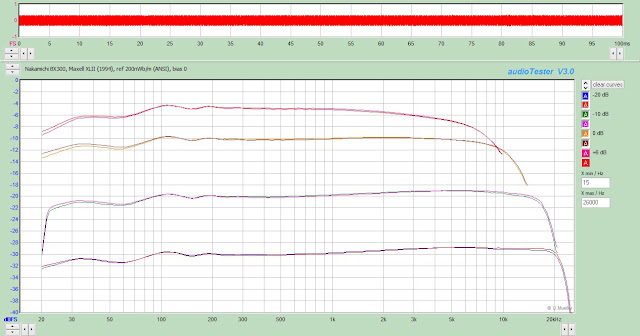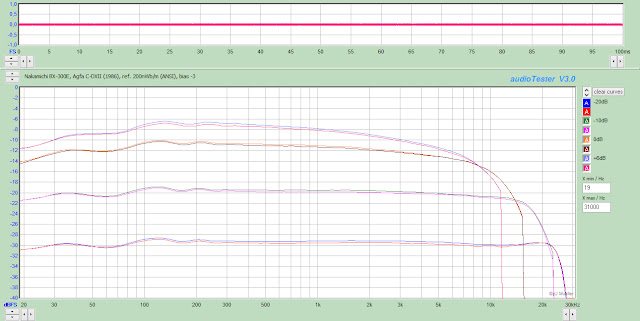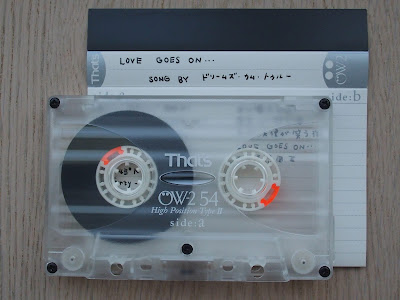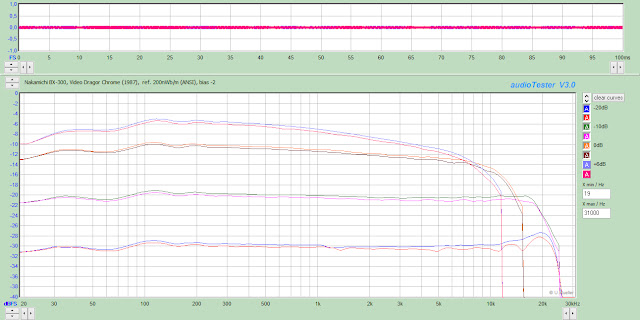In this series of cassette characterisations now a seemingly-random group of type IIs, including a few 'metal' type IIs (ferro-cobalt tapes with added pure metal particles).
For a detailed overview of the test methods used look here.
Maxell XLII 90 (1994) (my calibration reference)
Relative bias: (reference)Relative sensitivity: (reference)
THD @ Dolby level: 0.62%
MOL400(THD=1%) : +1.8dB
MOL400(THD=3%): +5.3dB
MOL1k(THD=3%): +5.5dB
SOL10k: -3.4dB
Bias noise: -54.8dB, -59.2dB(A)
Dynamic range: 64.5dB
I repeat here the results for the tape my Nak BX-300 is calibrated for in type II position, the 1994 XLII. All following results take this as reference.
Agfa CrII-S Superchrom HDX (1982)
Relative bias: -2.5Relative sensitivity: -2.2dB
THD @ Dolby level: 3.3%
MOL400(1%) : -7.5dB
MOL400(3%): -0.4dB
MOL1k(3%): -2.8dB
SOL10k: -7.4dB
Bias noise: -55.8dB, -60.6dB(A)
Dynamic range: 60.2dB
This is, uniquely, a ferro-chrome for the type II position. Here too the chrome layer has aged, losing its sensitivity (you can learn more on CrO2-aging here). Reducing bias flattens the curves, but the ferric layer cannot save the day and consequently MOL is very low. So is noise ... Like about all Agfas I tried from that era the shell is very chattery during winding.
Agfa C-DXII (1986)
Relative bias: -3Relative sensitivity: -3.5dB
THD @ Dolby level: 5.6%
MOL400(1%) : -9.4dB
MOL400(3%): -2.9dB
MOL1k(3%): -3.6dB
SOL10k: -7.7dB
Bias noise: -55.4dB, -60.1dB(A)
Dynamic range: 57.2dB
Agfa C-DXIIS (1986)
Relative bias: -3Relative sensitivity: -2.7dB
THD @ Dolby level: 3.7%
MOL400(1%) : -7.1dB
MOL400(3%): -0.8dB
MOL1k(3%): -3.0dB
SOL10k: -7.3dB
Bias noise: -54.8dB, -59.7dB(A)
Dynamic range: 58.9dB
Agfa SR (1989)
Relative bias: -2.5Relative sensitivity: -0.4dB
THD @ Dolby level: 1.4%
MOL400(1%) : -1.3dB
MOL400(3%): +3.2dB
MOL1k(3%): +2.9dB
SOL10k: -5.2dB
Bias noise: -53.8dB, -57.7dB(A)
Dynamic range: 60.9dB
And again something weird and wonderful from Agfa. This tape is greyish-black, yet it lacks the smell typical of chromium dioxide product. MOL, sensitivity, and noise are too high for degraded chrome, yet too low for a good ferro-cobalt tape. It is likely a magnetite-based ferro-cobalt, possibly the first type II with that chemistry. And that might make it the precursor of the 1991 Maxell XLII-S, if you know that there was cooperation between both manufacturers at that time!
Allegedly part of SR production was loaded with CrO2.
Akai GX (1991)
Relative bias: +4Relative sensitivity: -0.2dB
THD @ Dolby level: 0.70%
MOL400(1%) : +1.2dB
MOL400(3%): +4.7dB
MOL1k(3%): +5.4dB
SOL10k: -1.5dB
Bias noise: -50.3dB, -53.9dB(A)
Dynamic range: 58.6dB
This GX demands a high bias and returns the favour with decent-to-excellent (SOL!) headroom married to high noise, resulting in a dynamic range that is sub-par for a modern type II.
Denon HD-L Zippy II (1988, JDM)
Relative bias: -1.5Relative sensitivity: +0.4dB
THD @ Dolby level: 0.90%
MOL400(1%) : +0.6dB
MOL400(3%): +4.9dB
MOL1k(3%): +4.5dB
SOL10k: -3.9dB
Bias noise: -52.9dB, -56.5dB(A)
Dynamic range: 61.4dB
Being Japanese market it is hard to ascertain which European variant it corresponds to. Probably HD6 in a trendy shell.
Denon HD7S (1990)
Relative bias: +3Relative sensitivity: -0.1dB
THD @ Dolby level: 0.95%
MOL400(1%) : +0.3dB
MOL400(3%): +4.8dB
MOL1k(3%): +4.9dB
SOL10k: -2.6dB
Bias noise: -52.7dB, -56.5dB(A)
Dynamic range: 61.3dB
Denon HD8 (1988)
Relative bias: 0Relative sensitivity: +2.3dB
THD @ Dolby level: 0.65%
MOL400(1%) : +2.1dB
MOL400(3%): +6.7dB
MOL1k(3%): +6.7dB
SOL10k: +0.6dB
Bias noise: -50.3dB, -53.4dB(A)
Dynamic range: 60.1dB
This is the second metal particle type II I ever encountered (the first was a promo freebie That's EM-X that I could not appreciate back then). I purchased it from a hifi dealer who was kind enough to dub the soundtrack of a concert VHS onto it (we did not have a HiFi VHS at home). The video machine tracked horribly, and the recording was pretty bad. That as an aside.
Metal-enriched ferro-cobalt type II tapes as a breed should excel in SOL, giving a wider frequency response at -10 dB and 0 dB. They also tend to have a high sensitivity. Noise is high, of the same order of a decent ferric, but remember that this is with 70us equalisation, and that makes it a pretty bad performance in absolute terms. On the Cassette Deck 1 this tape required a very low bias and produced a mediocre MOL. Not so on the BX-300. Strange. Despite being hardly used this tape has worn badly.
Denon HD8 (1992)
Relative bias: -1Relative sensitivity: +1.7dB
THD @ Dolby level: 0.97%
MOL400(1%) : +0.2dB
MOL400(3%): +5.1dB
MOL1k(3%): +5.4dB
SOL10k: -0.9dB
Bias noise: -51.4dB, -54.5dB(A)
Dynamic range: 59.6dB
Compared to the previous edition MOL has taken a hit, while noise is somewhat better.
Magnex Chromdioxide Special (1978)
Relative bias: -1Relative sensitivity: -1.3dB
THD @ Dolby level: 1.9%
MOL400(1%) : -2.7dB
MOL400(3%): +1.6dB
MOL1k(3%): +1.4dB
SOL10k: -5.7dB
Bias noise: -52.5dB, -56.3dB(A)
Dynamic range: 57.9dB
It lacks the typical crayon smell, but the tape is black. Both the response curves and the bias noise are atypical for degraded chromium dioxide.
Mark II Super Chrome (1982)
Relative bias: -1.5Relative sensitivity: -4.0dB
THD @ Dolby level: 7.9%
MOL400(1%) : -9.5dB
MOL400(3%): -4.6dB
MOL1k(3%): -4.5dB
SOL10k: -5.6dB
Bias noise: -51.2dB, -55.9dB(A)
Dynamic range: 51.3dB
This is an early type II from a short-lived German budget brand. I was expecting BASF or Agfa chrome tape, but no ... The tape is black, but there is no crayon smell and its surface is somewhat rough. The evenly-spaced (remarkably bumpy) frequency response curves and the high bias noise suggest that this is not (degraded) chromium dioxide. On the other hand MOL and distortion are so bad that ferro-cobalt also seems unlikely. Whatever the formula really is, I would call this the worst type II cassette ever. Were it not, of course, that in 2021 NAC achieved the same sort of performance with its home-brew ferro-cobalt 799 MkIII!
Memorex CRS+ Chrome (1992)
Relative bias: +1.5Relative sensitivity: -0.1dB
THD @ Dolby level: 0.78%
MOL400(1%) : +1.0dB
MOL400(3%): +4.9dB
MOL1k(3%): +5.1dB
SOL10k: -2.4dB
Bias noise: -50.6dB, -54.7dB(A)
Dynamic range: 59.6dB
Made by Saehan. Very high noise.
Memorex CRS-X Chrome Super (1992)
Relative bias: +3Relative sensitivity: 0.0dB
THD @ Dolby level: 0.60%
MOL400(1%) : +1.8dB
MOL400(3%): +5.3dB
MOL1k(3%): +5.7dB
SOL10k: -1.8dB
Bias noise: -50.4dB, -53.8dB(A)
Dynamic range: 59.1dB
Made by Saehan. Probably the same tape as CRS+.
PDM 500 Crolyn HG (1983)
Relative bias: -3.5Relative sensitivity: -2.2dB
THD @ Dolby level: 3.1%
MOL400(1%) : -7.0dB
MOL400(3%): -0.3dB
MOL1k(3%): -1.4dB
SOL10k: -6.2dB
Bias noise: -55.9dB, -60.7dB(A)
Dynamic range: 60.4dB
Another aged chromium dioxide tape. Made in Switzerland (ICM?). This was a premium type, apparently single layer. (There was also a cheaper 500 Crolyn, with a mediocre score in Audio September 1983.) The frequency curves are quite reasonable. The dynamic range parameters are now entirely in line with 1982-1987 chromes from BASF and Philips.
PDM CD (1990)
Relative bias: -1Relative sensitivity: +0.2dB
THD @ Dolby level: 0.75%
MOL400(1%) : +1.3dB
MOL400(3%): +5.2dB
MOL1k(3%): +5.2dB
SOL10k: -3.2dB
Bias noise: -53.1dB, -57.0dB(A)
Dynamic range: 62.2dB
A neutral tape, with parameters in-between 1988 SA and 1994 XLII.
Quite confusingly in 1990 PDM offered three 'CD' models, with nearly-identical looks. One, like my sample here, said 'chrome position' and contained ferro-cobalt tape. It has the same shell as Fuji DR-I and was likely SKC QX. A second version with different hubs was made by General Magnetics, who also manufactured for That's. (To add to the confusion, the above sample measures nearly the same as That's OW-2, as you can see further down this page.) Finally, the third 'CD' had the legend 'chrome' and contained chromium dioxide tape (the same as Philips UCX). This 'CD' is discussed in the next section.
PDM CD (1990)
Relative bias: -2.5
Relative sensitivity: -3.2dB
THD @ Dolby level: 3.6%
MOL400(1%) : -8.5dB
MOL400(3%): -0.8dB
MOL1k(3%): -1.8dB
SOL10k: -7.1dB
Bias noise: -56.3dB, -61.3dB(A)
Dynamic range: 60.5dB
Made by ICM with Agfa or BASF tape.
Permaton Chrom Super II (1984?)
Relative bias: -3.5Relative sensitivity: -0.7dB
THD @ Dolby level: 3.0%
MOL400(1%) : -4.1dB
MOL400(3%): 0dB
MOL1k(3%): -0.5dB
SOL10k: -3.7dB
Bias noise: -52.1dB, -55.6dB(A)
Dynamic range: 55.6dB
This one smells like CrO2, but noise is very high, while MOLs are uncharacteristic.
Philips Chromium (1978)
Relative bias: -5Relative sensitivity: -1.9dB
THD @ Dolby level: 3.5%
MOL400(1%) : -7.4dB
MOL400(3%): -1.0dB
MOL1k(3%): -1.8dB
SOL10k: -8.1dB
Bias noise: -55.6dB, -59.6dB(A)
Dynamic range: 58.6dB
Philips UC-II (1984)
Relative bias: -3Relative sensitivity: -2.9dB
THD @ Dolby level: 3.7%
MOL400(1%) : -8.3dB
MOL400(3%): -1.1dB
MOL1k(3%): -2.2dB
SOL10k: -7.1dB
Bias noise: -56.1dB, -61.2dB(A)
Dynamic range: 60.1dB
Philips UCX (1987)
Relative bias: -2Relative sensitivity: -3.2dB
THD @ Dolby level: 3.0%
MOL400(1%) : -7.3dB
MOL400(3%): 0.0dB
MOL1k(3%): -1.3dB
SOL10k: -7.8dB
Bias noise: -56.1dB, -61.2dB(A)
Dynamic range: 61.2dB
Philips MCX (1987)
Relative bias: -3Relative sensitivity: -2.2dB
THD @ Dolby level: 3.3%
MOL400(1%) : -7.6dB
MOL400(3%): -0.6dB
MOL1k(3%): -2.4dB
SOL10k: -7.1dB
Bias noise: -56.6dB, -61.8dB(A)
Dynamic range: 61.2dB
The premium version of the UCX. Curiously it came with the flimsiest of j-cards I have ever seen, making it look and feel like the budget cousin to UCX! Performance is typical of age-degraded chrome. Bias noise is the lowest I have ever measured, though, together with BASF Chrome Super II.
Philips CD Extra (1990)
Relative bias: -1.5
Relative sensitivity: -0.8dB
THD @ Dolby level: 2.3%
MOL400(1%) : -3.6dB
MOL400(3%): +1.1dB
MOL1k(3%): -1.0dB
SOL10k: -2.6dB
Bias noise: -52.3dB, -56.1dB(A)
Dynamic range: 57.2dB
Around this time Philips sourced cassette parts from whoever wanted to sell. Hard to tell where this budget model originated. Perhaps GreenCorp? The tape is greyish-black. The leader looks like a poorly-made copy of Maxell. I also have a version of the same cassette with solid grey hubs. Both tapes appear to be the same, although one seems to be a bit less smooth. At any rate, the smoother of the two sticks and is actually useless.
This cassette has the dubious honour of being the worst modern specialist-brand ferro-cobalt type II in my collection. MOL is incredibly low, as low as degraded chrome. Noise is high, almost as high as type II metal. Frequency response is uneven. The only redeeming features are a high SOL and a widely extended response at -10dB and 0dB. Such a performance may have been acceptable in 1980, but not in 1990!
Pioneer C1 (1981)
Relative bias: -2Relative sensitivity: +0.4dB
THD @ Dolby level: 0.90%
MOL400(1%): +0.6dB
MOL400(3%): +3.2dB
MOL1k(3%): +3.6dB
SOL10k: -3.0dB
Bias noise: -51.7dB, -55.2dB(A)
Dynamic range: 58.4dB
Fuji FX-II in disguise.
RAKS HD-X II (1988)
Relative bias: -4Relative sensitivity: +0.1dB
THD @ Dolby level: 2.3%
MOL400(1%) : -3.4dB
MOL400(3%): +1.0dB
MOL1k(3%): +1.1dB
SOL10k: -4.2dB
Bias noise: -52.8dB, -56.5dB(A)
Dynamic range: 57.5dB
RAKS SD-X (1990)
Relative bias: -2Relative sensitivity: +0.5dB
THD @ Dolby level: 1.0%
MOL400(1%) : 0dB
MOL400(3%): +4.5dB
MOL1k(3%): +4.7dB
SOL10k: -3.2dB
Bias noise: -53.5dB, -57.3dB(A)
Dynamic range: 61.8dB
RAKS SD-S (1993)
Relative bias: -2Relative sensitivity: 0dB
THD @ Dolby level: 1.4%
MOL400(1%) : -1.7dB
MOL400(3%): +3.1dB
MOL1k(3%): +2.8dB
SOL10k: -3.6dB
Bias noise: -53.6dB, -57.4dB(A)
Dynamic range: 60.5dB
A budget product, hailing from the early years of cassette's decline.MOL is poor, but noise is decent. As far as I know the same cassette resurfaced post-2000 under the name 'Maxell SQ'.
Realistic Supertape Chrome Plus (1983)
Relative bias: -3Relative sensitivity: -3.8dB
THD @ Dolby level: 6.6%
MOL400(1%) : -10.2dB
MOL400(3%): -3.6dB
MOL1k(3%): -4.2dB
SOL10k: -8.1dB
Bias noise: -55.4dB, -59.9dB(A)
Dynamic range: 56.3dB
Made by ICM.
Realistic Supertape HB Plus (1992)
Relative bias: 0Relative sensitivity: -0.1dB
THD @ Dolby level: 0.80%
MOL400(1%) : +1.0dB
MOL400(3%): +5.1dB
MOL1k(3%): +5.3dB
SOL10k: -2.6dB
Bias noise: -52.4dB, -56.1dB(A)
Dynamic range: 61.2dB
Made by SKC.
Scotch Chrome (1974)
Relative bias: -5Relative sensitivity: -2.0dB
THD @ Dolby level: 3.0%
MOL400(1%) : -6.3dB
MOL400(3%): +0.0dB
MOL1k(3%): -1.3dB
SOL10k: -8.0dB
Bias noise: -54.7dB, -58.5dB(A)
Dynamic range: 58.5dB
Scotch Chrome (1976)
Relative bias: -5Relative sensitivity: -1.9dB
THD @ Dolby level: 3.4%
MOL400(1%) : -7.3dB
MOL400(3%): -0.6dB
MOL1k(3%): -1.4dB
SOL10k: -7.8B
Bias noise: -54.2dB, -57.7dB(A)
Dynamic range: 57.1dB
Scotch Master II (1977)
Relative bias: -3
Relative sensitivity: +1.5dB
THD @ Dolby level: 0.87%
MOL400(1%) : +0.8dB
MOL400(3%): +5.3dB
MOL1k(3%): +4.5dB
SOL10k: -3.4dB
Bias noise: -51.7dB, -55.3dB(A)
Dynamic range: 60.6dB
Sources position this tape in 1977, but some version of Master II always seemed available in some market until 1981. Overall performance is excellent for 1981, and outright stunning for 1977, beating SA and UD-XLII. Bias noise is low, next to contemporary ferro-cobalts. Remember that Scotch's type IV tape of the same series, Metafine, also had lower noise than its direct competitors.
Klangbild September 1980 warns that early issues of this cassette were loaded with black tape, with lesser magneto-acoustical performance, and with problematic mechanical properties.
Scotch Master III (1978)
Relative bias: 0Relative sensitivity: +0.6dB
THD @ Dolby level: 1.0%
MOL400(1%) : 0dB
MOL400(3%): +4.4dB
MOL1k(3%): +1.5dB
SOL10k: -8.0dB
Bias noise: -52.8dB, -57.1dB(A)
Dynamic range: 61.5dB
Strictly speaking this one does not belong here, but as it is my only type III ferro-chrome it has to live somewhere, not?
A bit of history ... Around 1976 it became clear that in real-world conditions CrO2 was not quite as performant as anticipated, the main reason being that many affordable decks had to underbias the tape in order to avoid magnetic saturation of the head. Further, compared to premium Fe2O3 tapes CrO2 was less sensitive and offered a lower bass and midrange MOL. The (expensive) solution comprised a two-layer tape: a thick inner layer with iron oxide and a thin outer layer with chromium dioxide. The former was to store low frequencies, the latter high frequencies. As where the medium frequencies had to go ... well ...
Ferrichrome was to be operated at a slightly higher bias than ordinary ferric. This would guarantee a high MOL, while the underbiased chrome layer would take care of SOL and treble sensitivity. Opting for 70us playback equalisation then ensured low noise, potentially leading to the highest dynamic range of all tape types at that time. Ideally the recorder would be equipped with a dedicated FeCr position, not just for the elevated bias, but more importantly for straightening out the crossover region in the midrange. In practice FeCr had its own class of problems, not just cost, and the arrival of metal tape in 1979 meant its demise.
Back to my (Italian-made) Master III ... What to do with such a sample today, without a deck equipped with the necessities for FeCr? I started with the most logical combination: type I bias and 70us. The expectation was that the ferro layer would still be healthy, while the chrome layer would have lost sensitivity, demanding a lower bias than normal for obtaining a flat frequency response. And this is indeed how it was borne out (after first having had to rescue the tape which was entirely locked up due to a variant of sticky shed syndrome). The ferric layer proved happy enough with centerline bias and responded with fine MOL and sensivity, while the chrome layer still provided a decent treble response, albeit with saturation very quickly rising with level (due to the hard treble drive of the recording equaliser). As for the midrange and lower treble ...
In a bid to flatten out the low treble I reduced bias massively. This did the trick, but now high treble peaked astronomically, while MOL400(3%) dropped to a paltry 0dB:
And then medium bias again, now with 120us equalisation: similar to the original curves, but with less treble saturation.
Scotch XSII (1982)
Relative bias: -2.5Relative sensitivity: +1.1dB
THD @ Dolby level: 1.2%
MOL400(1%) : -0.5dB
MOL400(3%): +3.7dB
MOL1k(3%): +3.2dB
SOL10k: -4.2dB
Bias noise: -51.2dB, -54.4dB(A)
Dynamic range: 58.1dB
Scotch only in name, this is a 1981 Denon DX7 in disguise. Its compatibility parameters are clearly modelled on contemporary TDK SA, but its performance does not even reach the level of 1979 SA!
Scotch XSII (1988)
Relative bias: +0.5Relative sensitivity: -0.9dB
THD @ Dolby level: 1.8%
MOL400(1%) : -2.6dB
MOL400(3%): +2.3dB
MOL1k(3%): +2.4dB
SOL10k: -3.0dB
Bias noise: -52.9dB, -56.9dB(A)
Dynamic range: 59.2dB
Made by SKC. Low MOL, with compression starting well below Dolby flux.
SKC QX (1988)
Relative bias: +0.5Relative sensitivity: -0.5dB
THD @ Dolby level: 1.0%
MOL400(1%) : 0dB
MOL400(3%): +4.3dB
MOL1k(3%): +4.5dB
SOL10k: -3.8dB
Bias noise: -52.8dB, -56.7dB(A)
Dynamic range: 61.0dB
TEAC HDX (1984)
Relative bias: -2.5Relative sensitivity: +2.3dB
THD @ Dolby level: 0.95%
MOL400(1%) : +0.2dB
MOL400(3%): +5.1dB
MOL1k(3%): +4.7dB
SOL10k: -0.1dB
Bias noise: -50.0dB, -53.2dB(A)
Dynamic range: 58.3dB
This is clearly an early Taiyo Yuden metal tape for type II. Also see That's here below.
That's EX (1987)
Relative bias: -2.5Relative sensitivity: +2.5dB
THD @ Dolby level: 0.85%
MOL400(1%) : +0.8dB
MOL400(3%): +5.4dB
MOL1k(3%): +5.7dB
SOL10k: 0.0dB
Bias noise: -51.0dB, -54.2dB(A)
Dynamic range: 59.6dB
Taiyo Yuden (That's, Triad) specialised in metal and metal-for-type-II tapes. Their first of the latter type was 1983's EM-X, followed with the cheaper EX in 1987. According to Audio 10/1988 EX was very similar to EM-X, but with 1dB less dynamic range.
Bias and sensitivity make it incompatible. Noise is high, MOL is fine, SOL excellent, the frequency response is dished, like a two-layer tape, and the fine SOL can only be exploited with bright-sounding music.
That's CD/MH (1990)
Relative bias: -2Relative sensitivity: +2.5dB
THD @ Dolby level: 0.80%
MOL400(1%) : +0.8dB
MOL400(3%): +5.7dB
MOL1k(3%): +5.4dB
SOL10k: -0.3dB
Bias noise: -51.0dB, -54.0dB(A)
Dynamic range: 59.7dB
Once upon a time That's launched a super metal named SUONO. It's Giugiaro-designed heavyweight shell was later used in That's entire product line, albeit with a much lighter plastic: these cassettes bring in 16 grammes less than the real thing. The heavy shell later was adopted again in the BASF 353 series (read my warning here).
That's history, now back to CD/MH: it measures very close to EX, and probably contains the same tape.
That's OW-2 (1990, JDM)
Relative bias: -1Relative sensitivity: +0.3dB
THD @ Dolby level: 0.63%
MOL400(1%) : +1.8dB
MOL400(3%): +5.5dB
MOL1k(3%): +5.5dB
SOL10k: -3.7dB
Bias noise: -53.2dB, -57.2dB(A)
Dynamic range: 62.7dB
Japanese market, probably the same as European AS-II.
Video Dragor Chrome (1987)
Relative bias: -2Relative sensitivity: -2.1dB
THD @ Dolby level: 2.4%
MOL400(1%) : -5.3dB
MOL400(3%): +1.1dB
MOL1k(3%): -0.8dB
SOL10k: -6.1dB
Bias noise: -55.4dB, -60.8dB(A)
Dynamic range: 61.9dB
A Bulgarian cassette, made with BASF tape.
INDEX OF ALL CASSETTES




















































































